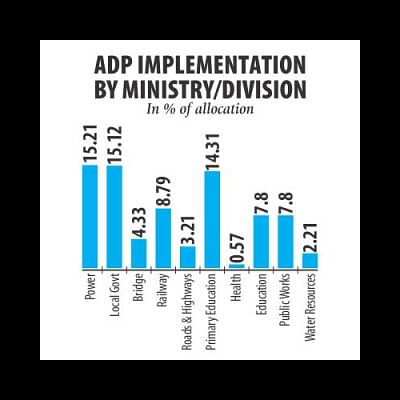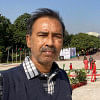Development spending shows signs of improvement

Development spending improved slightly in the first quarter of the fiscal year but it is still lagging far behind the historical trend.
Between the months of July to September, the ministries and divisions put to use 8.75 percent of their total outlay for fiscal 2016-17, up from 7 percent they managed a year earlier.
The slight increase would come as a setback to the government, which has taken a host of initiatives over the last two to three years to bump up development spending.
Since fiscal 2012-13, Annual Development Programme spending in percentage of the total outlay had been on the downslide.
In the first quarter of fiscal 2012-13, the total ADP implementation was 13 percent of their total outlay. The rate of implementation progressively decreased and last fiscal year the percentage stood at only 7 percent.
However, in terms of amount, spending had a big jump -- by about 59 percent -- in the first quarter of the fiscal year.
Some Tk 10,788 crore was spent in the first three months of the fiscal year, in contrast to Tk 6,806 crore, according to statistics from the Implementation, Monitoring & Evaluation Division.
This year, the ADP outlay is Tk 123,346 crore, which includes the development allocation for state-owned enterprises. Of the amount, Tk 110,700 crore would come from the government budget.
The ADP allocation for fiscal 2016-17 seems high in nominal terms, and it has crossed the Tk 1 trillion ($12.7 billion) mark, said the World Bank in its latest release of Bangladesh Development Update.
“As usual, implementation will remain challenging and based on past experience, actual ADP utilisation may be 15 to 20 percent less than the budgeted amount,” the Washington-based multilateral lender said.
However, the WB said the government has recently taken a number of initiatives to accelerate ADP implementation.
These include: the creation of a Project Preparatory Fund to facilitate quality at entry for timely and effective implementation of development projects; appointing project director through direct interviews by line ministries and divisions; assigning a dedicated official to each government agency for monitoring and evaluating respective projects and delisting longstanding 'non-operational' projects from the ADP.
“The IMED regularly provides recommendations in its annual progress reports based on the challenges faced during the project cycle. These require much better follow-up with implementing ministries,” the WB said.
As a result, ADP implementation snapped out of a declining trend this fiscal year. Some 10 large ministries and divisions got 73 percent of the allocation this year.
Six ministries and divisions -- housing and public works ministry, railways ministry, primary and mass education ministry, education ministry, power division and local government division -- spent higher than average.
The bridges division, road transport and highways division, health ministry, and water resources ministry spent much lower than the average.

 For all latest news, follow The Daily Star's Google News channel.
For all latest news, follow The Daily Star's Google News channel. 



Comments